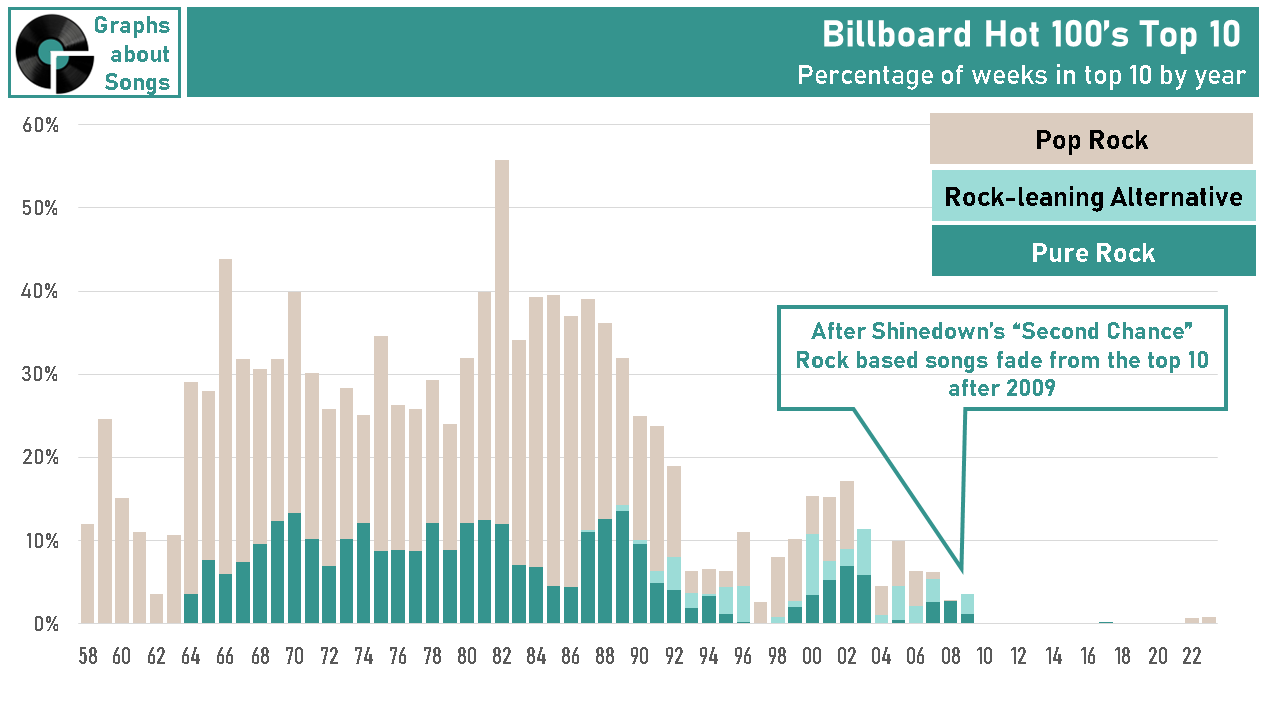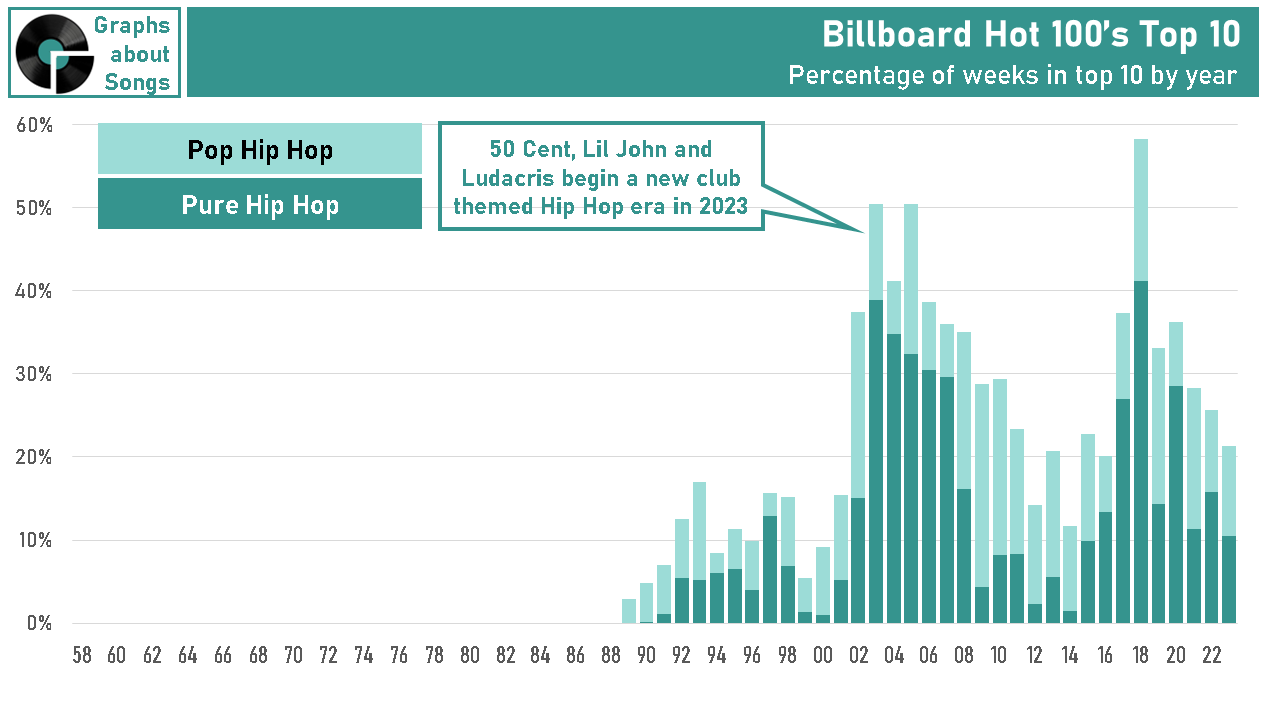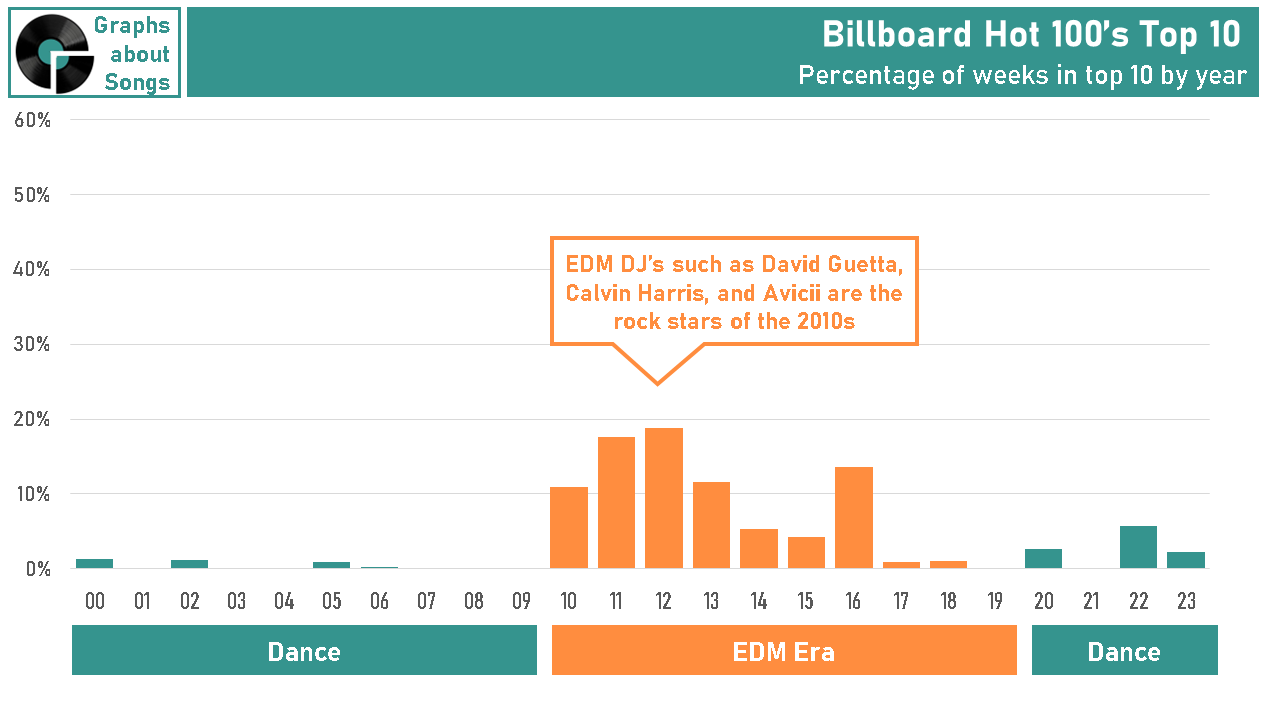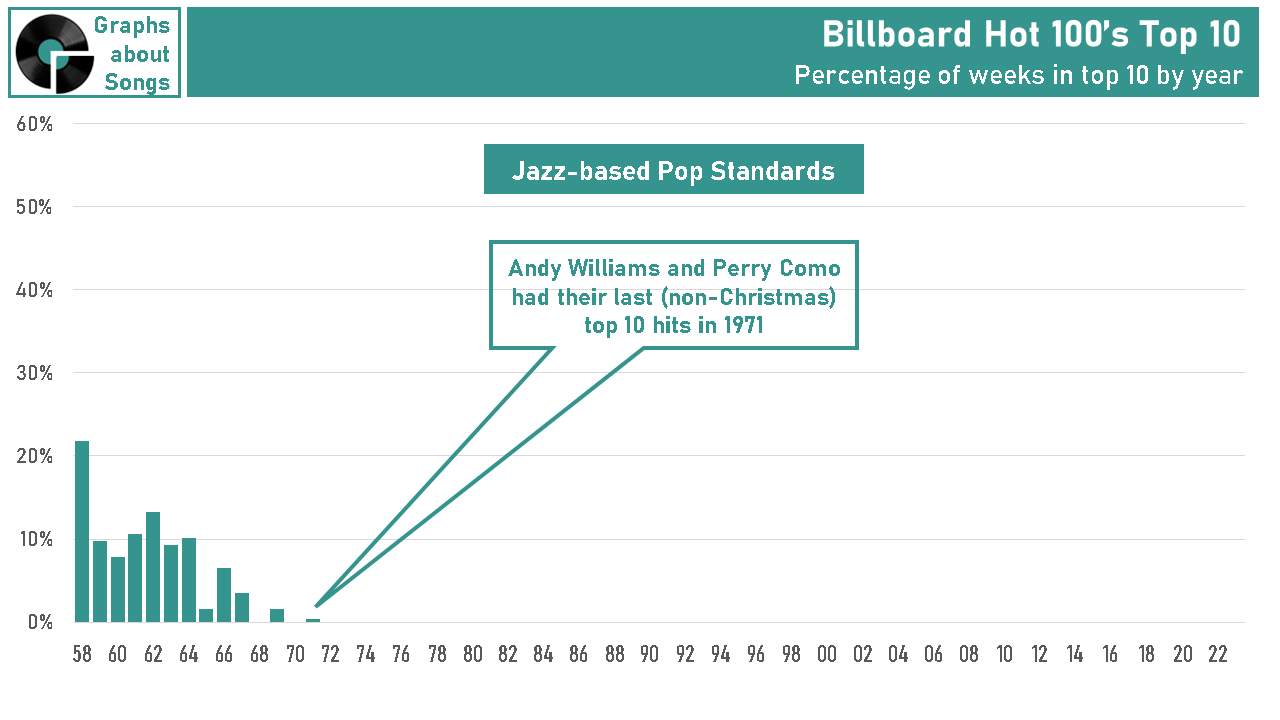Rock is Dead. Long Live Rock. (1955-2009)
This post is part of a series examining the Billboard Hot 100 from 1958 to 2023 and how time and technology has changed our understanding of hit music.
Where were you on June 20th, 2009?
It was a fateful day in pop music history. An era lasting over half a century was marking its end. On that day, Shinedown’s “Second Chance” reached its #3 peak on the Billboard Hot 100.
What, you don’t remember that day? You don’t even remember this Shinedown song?
It was the last pure Rock song that would reach the Hot 100’s top 10, ending a contiguous run of Rock in the Top 10 every year since the 1960s. If we consider what Casey Kasem colloquially called “the Rock era,” it’s the end of an era that started in 1955 when Bill Haley and the Comet’s Rock Around The Clock” hit #1, announcing Rock ‘n’ Roll’s arrival as the dominant music genre of young America.
Don’t feel bad if you missed it. It’s sometimes easy to spot the birth of a musical movement. America definitely noticed Rock ‘n’ Roll, the Beatles’ British Invasion, and “Smells Like Teen Spirit.”
It’s much harder to spot when a musical era is finally over. You’ll almost always need hindsight to clearly pinpoint it.
Let’s examine the percentage of songs by genre that were in the Billboard Hot 100’s top 10 in a typical week for every year from the chart’s inception in 1958 to 2023. The genre designations are my own. I’ve attempted to label each song using broad categories so we can compare songs and styles across the decades. Argue with my classifications in the comments.
ROCK’S EMERGENCE, EVOLUTION, AND END
The Rock era began when the R&B of young Black America fused with Country and traditional Pop to become Rock ‘n’ Roll, (which I’ve included in the “Pop Rock” genre on the chart above so we can trend to future decades.) Elvis Presley, the Everly Bothers, and Roy Orbison were a strong chart presence when Billboard’s Hot 100 debuted, but waned in the early ‘60s after the music died in 1959.
The British Invasion is best known for the Beatles. However, many of the other bands that sailed in with them—most successfully the Rolling Stones—brought the raw R&B energy of 1950s soul and blues that American artists seemingly forgot back to our shores. Coupled with American garage rock bands, the British helped ignite American Rock acts like The Doors and Credence Clearwater Revival.
The 1970s brought a softer sound with acts including The Eagles, Elton John, Linda Ronstadt (most songs of which are included in the Pop Rock category above), while Paul McCartney & Wings, Foreigner, The Steve Miller Band, Grand Funk Railroad were among the pure Rock acts spending the most weeks in the Hot 100’s top 10 during the ‘70s.
The 80s brought peak Rock (specifically in 1989), with hair bands like Bon Jovi, Poison, and Guns N' Roses dominating the Rock titles in the top 10, along with Van Halen earlier in the decade. The 80s also marked the high point of Pop Rock (specifically in 1982), with Phil Collins, Bruce Springsteen, Huey Lewis and the News, and Hall & Oats inescapable on Contemporary Hit Radio.
The 90s—famous for Grunge killing Hair Metal—saw Alternative Rock and Alternative-infused Pop songs from Hootie & The Blowfish, the Red Hot Chili Peppers, the Goo Goo Dolls, Soul Asylum, and Nirvana represent Rock in the top 10 of Billboard’s Hot 100.
The acts repping Rock in its final decade routinely reaching the Hot 100’s top 10 now feel like cheap copies of the authentic Alternative Rock of the 1990s, at least to us curmudgeonly Gen Xers: Three Doors Down, Linkin Park, Puddle of Mudd, Matchbox 20, Lifehouse, Creed, and (sigh) Nickelback defined Rock in the top 10 from 2000 to 2009.
Once Shinedown scored the last Rock song to reach the Hot 100’s top 10, America had had enough.
WHAT REPLACED ROCK?
Hip Hop is now the dominant music genre of youth culture. Duh.
But when exactly did Hip Hop overtake Rock specifically as the dominant music genre of youth culture?
Hip Hop’s arrival in the top 10—along with the Alternative derivation of Rock—coincided with Generation X taking over control of creating popular music in the early 1990s.
In the early 2000s, Millennials overtook Xers as the prime consumers of popular music. At that same time (2003 specifically), Hip Hop’s share of the Hot 100’s top 10 on any given week soared to over half of all top 10 titles. Just four years earlier (1999), Hip Hop was a scant five percent of top 10 songs in a typical week.
Throughout the 00s, Gen Xers remained the primary creators of Hip Hop, but the successful songs appealed to Millennials’ sensibilities: Think less gritty gang life and more clubbing. Lots of clubbing.
However, Hip Hop was not the genre that took Rock’s place in popular music when it died in 2009. In 2010, Millennials were not only the primary consumers of popular music, their generation also took over the dominant role of creating popular music
And the genre they created and made mainstream was EDM.
Electronic Dance Music (EDM) already found an underground youth audience in the ‘00s, thanks to producers such as Skrillex and Deadmau5. That music went mainstream overnight in 2010. DJ/Producers such as David Guetta, Calvin Harris, and Avicii (RIP) accounted for two of the top 10 chart slots on any given week by 2012, making EDM more popular than Hip Hop that year.
With the exception of the peak of the Disco craze, Dance music was never more successful on the Hot 100 than it was at peak EDM.
Pure EDM ultimately faded from the chart’s top 10 with a new Hip Hop resurgence in the late ‘10s. It never really went away, however. EDM elements remain a core building block of the hits we now simply consider Pop.
HAVE WE SEEN MUSICAL ERAS END BEFORE?
If you’re old enough to remember the early 1970s, you heard the death of the era that predated Rock, namely, the Jazz era.
Emerging in African-American culture in New Orleans at the dawn of the 20th century, Jazz was mainstream by the 1920s with Louis Armstrong and his contemporaries the soundtrack for Great Gadsby era Lost Generation culture.
During the Great Depression, the G.I. (Greatest) Generation sanded away Jazz’ improvisational edginess with Big Band. Bursting onto network radio in 1935, Benny Goodman, Tommy and Jimmy Dorsey, Glenn Miller, and other band leaders played dance halls in the late 1930s and early 1940s just as EDM DJs played clubs in the 2010s.
In the mid-1940s, Silent generation youth (the kids too young to fight in WWII) rejected Big Band for a more intimate sound of crooners like Frank Sinatra, Nat King Cole, and Perry Como, or as your kids know them, “Christmas music.” (Meanwhile, the avant-garde kids dug the frenetic yet intimate Bebop jazz style of Miles Davis, Charlie Parker, and Dizzy Gillespie.)
Those Jazz-era crooners like Frank Sinatra, Andy Williams, Dean Martin, and Peggy Lee kept having top 10 hits for over 15 years after Rock usurped Jazz as the dominant music of youth culture. Frank Sinatra staged a late-life comeback with 1966’s #1 "Strangers in the Night", followed in ’67 by the #1 duet with daughter Nancy, “"Somethin' Stupid", his last top 10.
Then in 1971, Perry Como and Andy scored their last top 10 hits with "It's Impossible” and "(Where Do I Begin?) Love Story," respectively.
No jazz-era artist would reach the top 10 with a contemporary (non-holiday) tune again.
WHY DOES THIS HISTORY MATTER?
The biggest danger of not knowing history is falsely assuming our current events are unprecedented.
Knowing your history—in this case pop music history—helps you notice patterns in how music genres emerge, evolve, and erode. Those patterns coincide with different generations becoming consumers and then creators of popular music.
If you go real oldskool, popular music’s progression from the Jazz to Rock to Hip Hop is no different from Classical music’s progression from the Baroque to Classical to Romantic eras.
When you understand the patterns of the past, you’re more prepared to predict the patterns of the future.
LONG LIVE ROCK
“But Matt,” I hear you say, “there are still Rock hits today! What about Harry Styles’ ‘Sign Of The Times’? What about Olivia Rodrigo’s ‘Vampire’? What about Måneskin?”
“"Beggin'", Måneskin’s highest charting U.S. hit, only reached #13. We’re analyzing the Hot 100’s top 10 songs here.
However, you do make an important point, Mr. Hypothetical Contrarian: Rock infused elements remain a building block of contemporary popular music, even if Rock music no longer defines youth culture. It’s no different than Steely Dan infusing Jazz during Rock’s heyday.
Furthermore, just because an era of contemporary music defining youth culture has come and gone does not mean younger generations don’t embrace the best of past eras. Having a Led Zepplin / Pink Floyd phase has been a tradition for decades of adolescents. Teens today consider Nirvana and Green Day pantheons of Classic Rock.
In many U.S. cities, more 18- to 29-year-olds listen to the local Classic Rock station than the hit music station.
So yes, Rock is now firmly established in humanity’s musical cannon alongside Jazz and Classical.
Meanwhile, a pop music evolution is on the near horizon. Have you spotted it yet?
Sources for this post:
The Billboard Hot 100: https://www.billboard.com/charts/hot-100
Wikipedia’s Billboard Hot 100 Top 10 singles: https://en.wikipedia.org/wiki/List_of_Billboard_Hot_100_top-ten_singles







Thanks for this, but short correction on one point. Two jazz-era vocalists continued to have Top 10 hits: Barbra Streisand (two of her three #1s were ballads) and Johnny Mathis (who hit #1 in 1978.) Mathis recorded his first album the same year Andy Williams did.
You said Shinedown in 2009 was the last rock song, but what is the data point in 2017? And what are the pop rock songs that come up starting in 2022?